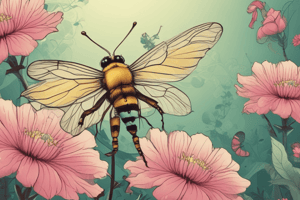Podcast
Questions and Answers
Name two features visible in the image of Rose sweet pea that indicate the flower is cross-pollinated.
Name two features visible in the image of Rose sweet pea that indicate the flower is cross-pollinated.
Two features visible in the image of Rose sweet pea that indicate the flower is cross-pollinated are the presence of multiple stamens and a well-developed stigma.
What is meant by cross-pollination? List two other agents of pollination.
What is meant by cross-pollination? List two other agents of pollination.
Cross-pollination refers to the transfer of pollen from the anther of one flower to the stigma of another flower. Two other agents of pollination are wind and insects.
Explain self-pollination.
Explain self-pollination.
Self-pollination refers to the transfer of pollen from the anther to the stigma within the same flower or within flowers of the same plant.
Label the parts of the chromosome.
Label the parts of the chromosome.
Outline the differences between mitosis and meiosis.
Outline the differences between mitosis and meiosis.
Match the following tasks with their corresponding descriptions:
Match the following tasks with their corresponding descriptions:
Match the following biological concepts with their definitions:
Match the following biological concepts with their definitions:
Match the following terms with their related biological processes:
Match the following terms with their related biological processes:
Match the following flower characteristics with their pollination types:
Match the following flower characteristics with their pollination types:
Match the following tasks with their corresponding subject areas:
Match the following tasks with their corresponding subject areas:
Flashcards
Cross-Pollination
Cross-Pollination
Pollen is transferred from the anther of one flower to the stigma of another flower of the same species.
Self-Pollination
Self-Pollination
Pollen is transferred from the anther of a flower to the stigma of the same flower or another flower on the same plant.
Centromere
Centromere
The constricted region of a chromosome where sister chromatids attach during cell division.
Chromatids
Chromatids
Signup and view all the flashcards
Telomeres
Telomeres
Signup and view all the flashcards
Genes
Genes
Signup and view all the flashcards
Mitosis
Mitosis
Signup and view all the flashcards
Meiosis
Meiosis
Signup and view all the flashcards
Matching Tasks
Matching Tasks
Signup and view all the flashcards
Distinguishing Mitosis and Meiosis
Distinguishing Mitosis and Meiosis
Signup and view all the flashcards
Study Notes
Cross-Pollination
- Features:
- Different flower structures: The image shows the stigma and style are positioned above the anther.
- Brightly colored petals: Bright colors and pleasant scents can attract pollinators to the flowers.
- Definition: Cross-pollination involves the transfer of pollen from the anther of one flower to the stigma of another flower of the same species.
- Agents:
- Insects (like bees and butterflies)
- Wind
Self-Pollination
- Definition: Self-pollination occurs when pollen from the anther of a flower is transferred to the stigma of the same flower or another flower on the same plant.
Chromosome Parts
- Centromere: Constricted region of the chromosome where the sister chromatids attach.
- Chromatids: Two identical copies of a chromosome joined at the centromere, formed during DNA replication.
- Telomeres: Protective caps at the ends of chromosomes that prevent degradation of DNA.
- Genes: Functional units of heredity located on chromosomes.
Mitosis vs. Meiosis
- Mitosis:
- Purpose: Growth, repair, and asexual reproduction.
- Daughter cells: Two daughter cells genetically identical to the parent cell.
- Chromosomes: Number of chromosomes remains the same.
- Meiosis:
- Purpose: Sexual reproduction.
- Daughter cells: Four daughter cells with half the number of chromosomes as the parent cell.
- Chromosomes: Number of chromosomes is halved.
- Genetic diversity: Generates genetic variation through crossing over and independent assortment.
Match the Following Tasks
- Matching tasks with descriptions: This task requires you to identify the appropriate description for a given task.
- Matching biological concepts with definitions: You need to connect the definitions of specific biological concepts correctly.
- Matching terms with biological processes: Matching specific terms to the processes they are related to.
- Matching flower characteristics with pollination types: Identifying the pollination type associated with specific flower characteristics.
- Matching tasks with subject areas: This involves classifying tasks based on their corresponding subject areas of study.
Studying That Suits You
Use AI to generate personalized quizzes and flashcards to suit your learning preferences.




